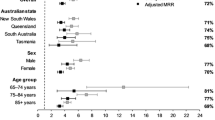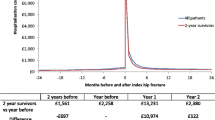Abstract
Summary
This study provides evidence that a number of frailty-related characteristics (older age, de novo admission to long-term care (LTC), comorbidities [Charlson Index, osteoporosis, osteoporosis risk factors, sarcopenia risk factors, and dementia]) have increased in the hip fracture population from 2001–2008. This will have significant impact on community resources, as the number of people discharged to the community is also increasing.
Introduction
The aim of this study is to estimate secular changes in the prevalence of selected frailty-related characteristics among the hip fracture population in the Canadian province of Quebec (2001–2008) and the potential impact of these changes on healthcare services.
Methods
The Quebec hospitalization database was used to identify nontraumatic hip fractures for the purposes of calculating age- and sex-specific rates. Also estimated were time trends for selected frailty-related characteristics and discharge destinations.
Results
A significant decline in fracture rates was evident for all age groups except for those <65; sex differences were also observed. Almost all frailty-related characteristics increased over time, ranging from 2 to 14 % per year, which translates to an estimated increase from 16 to 112 %, over the study period. For those whose prior living arrangement was LTC, rates of hip fractures declined significantly (women OR = 0.93, 0.91–0.95; men OR = 0.97, 0.94–0.99). In-hospital mortality and discharge to inpatient rehabilitation decreased, while discharges back to community and to LTC increased.
Conclusions
Although hip fracture rates decreased for older hip fracture patients, the absolute number and prevalence of specific frailty-related characteristics increased. Policy makers should review care models to ensure that adequate resources are provided to the community to offset the expected increase in demand arising from ongoing changes in patients’ characteristics.


Similar content being viewed by others
References
Cooper C, Campion G, Melton LJ III (1992) Hip fractures in the elderly: a worldwide projection. Osteoporos Int 2:285–289
Cooper C, Barker DJ (1995) Risk factors for hip fracture. N Engl J Med 332:814–815
Papadimitropoulos EA, Coyte PC, Josse RG, Greenwood CE (1997) Current and projected rates of hip fracture in Canada. CMAJ 157:1357–1363
The Canadian Institute for Health Information (CIHI) (2010) Wait times for hip fracture repair in Quebec similar to those in Ontario and Alberta. http://www.cihi.ca/CIHI-ext-portal/internet/EN/Home/home/cihi000001. Accessed March 2013
Fried LP, Ferrucci L, Darer J, Williamson JD, Anderson G (2004) Untangling the concepts of disability, frailty, and comorbidity: implications for improved targeting and care. J Gerontol Ser A: Biol Sci Med Sci 59:M255–M263
Espinoza S, Walston JD (2005) Frailty in older adults: insights and interventions. Cleve Clin J Med 72:1105–1112
Mitnitski A, Graham J, Mogilner A, Rockwood K (2002) Frailty, fitness, and late-life mortality in relation to chronological and biological age. BMC Geriatr 2:1
Shatenstein B (2011) Frailty and cognitive decline: links, mechanisms, and future directions. J Nutr Health & Aging 15:665–666
Samper-Ternent R, Snih A, Soham R, Mukaila A, Markides KS, Ottenbacher KJ (2008) Relationship between frailty and cognitive decline in older Mexican Americans. J Am Geriatr Soc 56:1845–1852
Kulminski AM, Ukraintseva SV, Kulminskaya IV, Arbeev KG, Land K, Yashin AI (2008) Cumulative deficits better characterize susceptibility to death in elderly people than phenotypic frailty: lessons from the cardiovascular health study. J Am Geriatr Soc 56:898–903
Ensrud KE, Ewing SK, Taylor BC, Fink HA, Stone KL, Cauley JA, Tracy JK, Hochberg MC, Rodondi N, Cawthon PM (2007) Frailty and risk of falls, fracture, and mortality in older women: the study of osteoporotic fractures. J Gerontol Ser A Biol Sci Med Sci 62:744–751
Rolland Y, Abellan V, Kan G, Benetos A, Blain H, Bonnefoy M, Chassagne P, Jeandel C, Laroche M, Nourhashemi F, Orcel P, Piette F, Ribot C, Ritz P, Roux C, Taillandier J, Tremollieres F, Weryha G, Vellas B (2008) Frailty, osteoporosis, and hip fracture: causes, consequences, and therapeutic perspectives. J Nutr Health Aging 12:335–346
Charlson ME, Pompei P, Ales KL, MacKenzie CR (1987) A new method of classifying prognostic comorbidity in longitudinal studies: development and validation. J Chron Dis 40:373–383
Levy AR, Mayo NE, Grimard G (1995) Rates of transcervical and pertrochanteric hip fractures in the province of Quebec, Canada, 1981–1992. Am J Epidemiol 142:428–436
Deyo RA, Cherkin DC, Ciol MA (1992) Adapting a clinical comorbidity index for use with ICD-9-CM administrative databases. J Cli Epidemiol 45:613–619
Statistics Canada (2011) Estimates of population, by age group and sex, Canada, provinces and territories. http://www5.statcan.gc.ca/cansim/. Accessed March 2013
Mayo NE, Nadeau L, Daskalopoulou SS, Cote R (2007) The evolution of stroke in Quebec: a 15-year perspective. Neurology 68:1122–1127
Leslie WD, O’ Donnell S, Jean S (2009) Trends in hip fracture rates in Canada. JAMA: J Am Med Assoc 302:883–889
Wildner M, Clark DE (2001) Hip fracture incidence in east and west Germany: reassessment 10 years after unification. Osteoporos Int 12:136–139
Kannus P, Niemi S, Parkkari J, Palvanen M, Vuori l, Järvinen M (1999) Hip fractures in Finland between 1970 and 1997 and predictions for the future. Lancet 353:802–805
Holt G, Smith R, Duncan K, Hutchison JD, Reid D (2009) Changes in population demographics and the future incidence of hip fracture. Injury 40:722–726
Finsen V, Johnsen LG, Trano G, Hansen B, Sneve KS (2004) Hip fracture incidence in central Norway: a follow-up study. Clin Orthop Relat Res 173–178
Hernandez JL, Olmos JM, Alonso MA, Gonzalez-Fernandez CR, Martinez J, Pajaron M, Llorca J, Gonzalez-Macias J (2006) Trend in hip fracture epidemiology over a 14-year period in a Spanish population. Osteoporos Int 17:464–470
Melton L, Kearns A, Atkinson E, Bolander M, Achenbach S, Huddleston J, Therneau T, Leibson C (2009) Secular trends in hip fracture incidence and recurrence. Osteoporos Int 20:687–694
Fisher AA, O’Brien ED, Davis MW (2009) Trends in hip fracture epidemiology in Australia: possible impact of bisphosphonates and hormone replacement therapy. Bone 45:246–253
Lofman O, Berglund K, Larsson L, Toss G (2002) Changes in hip fracture epidemiology: redistribution between ages, genders, and fracture types. Osteoporos Int 13:18–25
Chevalley T, Guilley E, Herrmann FR, Hoffmeyer P, Rapin CH, Rizzoli R (2007) Incidence of hip fracture over a 10-year period (1991–2000): reversal of a secular trend. Bone 40:1284–1289
Jaglal SB, Weller I, Mamdani M, Hawker G, Kreder H, Jaakkimainen L, Adachi JD (2005) Population trends in BMD testing, treatment, and hip and wrist fracture rates: are the hip fracture projections wrong? J Bone Miner Res 20:898–905
Vanasse A, Orzanco MG, Dagenais P, Ouarda T, Courteau J, Asghari S, Chebana F, Martel B, Gosselin P (2012) Secular trends of hip fractures in Quebec. Can Osteoporos Int 23:1665–1672
Zetterberg C, Elmerson S, Andersson GB (1984) Epidemiology of hip fractures in Goteborg, Sweden, 1940–1983. Clin Orthop Relat Res 43–52
Nilsson BE, Obrant KJ (1978) Secular tendencies of the incidence of fracture of the upper end of the femur. Acta Orthop Scand 49:389–391
Haleem S, Lutchman L, Mayahi R, Grice JE, Parker MJ (2008) Mortality following hip fracture: trends and geographical variations over the last 40 years. Injury 39:1157–1163
Abrahamsen B, van Staa T, Ariely R, Olson M, Cooper C (2009) Excess mortality following hip fracture: a systematic epidemiological review. Osteoporos Int 20:1633–1650
Morin S, Lix L, Azimaee M, Metge C, Majumdar S, Leslie W (2011) Institutionalization following incident nontraumatic fractures in community-dwelling men and women. Osteoporosis International 23(9):2381–2386
Bonar SK, Tinetti ME, Speechley M, Cooney LM (1990) Factors associated with short- versus long-term skilled nursing facility placement among community-living hip fracture patients. J Am Geriatr Soc 38:1139–1144
Melton LJ III (2003) Adverse outcomes of osteoporotic fractures in the general population. J Bone Miner Res 18:1139–1141
Wiktorowicz ME, Goeree R, Papaioannou A, Adachi JD, Papadimitropoulos E (2001) Economic implications of hip fracture: health service use, institutional care, and cost in Canada. Osteoporos Int 12:271–278
Fitzgerald JF, Moore PS, Dittus RS (1988) The care of elderly patients with hip fracture. N Engl J Med 319:1392–1397
Sebestyen A, Boncz I, Toth F, Pentek M, Nyarady J, Sandor J (2008) Correlation between risk factors and mortality in elderly patients with femoral neck fracture with 5-year follow-up. Orv Hetil 149:493–503
Cadarette SM, Katz JN, Brookhart MA, Levin R, Stedman MR, Choudhry NK, Solomon DH (2008) Trends in drug prescribing for osteoporosis after hip fracture, 1995–2004. J Rheumatol 35:319–326
Salgueiro ME, Manso G, Castells X, Jimeno FJ, Ordonez L, Gonzalez V, Rodriguez A, Capella D (2013) Trends in the pharmacological treatment of osteoporosis in Spain from 2000 to 2008. Maturitas 74:74–78
Stafford RS, Drieling RL, Hersh AL (2004) National trends in osteoporosis visits and osteoporosis treatment, 1988–2003. Arch Intern Med 164:1525–1530
Friedman SM, Menzies IB, Bukata SV, Mendelson DA, Kates SL (2010) Dementia and hip fractures. Geriatr Orthop Surg Rehabil 1:52–62
Bertram M, Norman R, Kemp L, Vos T (2011) Review of the long-term disability associated with hip fractures. Inj Prev 17:365–370
The American Academy of Orthopedic Surgeons (2008) Hip Fracture in Seniors: A Call for Health System Reform. http://www.aaos.org/about/papers/position/1144.asp. Accessed March 2013
El Maghraoui A, Ngbanda A, Bensaoud N, Bensaoud M, Rezqi A, Tazi M (2013) Age-adjusted incidence rates of hip fractures between 2006 and 2009 in Rabat, Morocco. Osteoporos Int 24:1267–1273
Boufous S, Finch CF, Lord SR (2004) Incidence of hip fracture in New South Wales: are our efforts having an effect? Med J Aust 180:623–626
Gehlbach SH, Avrunin JS, Puleo E (2007) Trends in hospital care for hip fractures. Osteoporos Int 18:585–591
Marks R (2010) Hip fracture epidemiological trends, outcomes, and risk factors, 1970–2009. Int J Gen Med 3:1–17
Mazzaferro S, Pasquali M, Pirro G, Rotondi S, Tartaglione L (2010) The bone and the kidney. Arch Biochem Biophys 503:95–102
Buford TW, Anton SD, Judge AR, Marzetti E, Wohlgemuth SE, Carter CS, Leeuwenburgh C, Pahor M, Manini TM (2010) Models of accelerated sarcopenia: critical pieces for solving the puzzle of age-related muscle atrophy. Ageing Res Rev 9:369–383
Unnanuntana A, Rebolledo BJ, Khair MM, DiCarlo EF, Lane JM (2011) Diseases affecting bone quality: beyond osteoporosis. Clin Orthop Relat Res 469:2194–2206
Balzarini L, Mancini C, Mouzakiti P, Confortini M, Marvisi M (2011) Osteoporosis associated with chronic obstructive pulmonary disease and other respiratory diseases. Recenti Prog Med 102:359–366
Boling EP (2004) Secondary osteoporosis: underlying disease and the risk for glucocorticoid-induced osteoporosis. Clin Ther 26:1–14
Embutnieks IUV, Drozdov VN, Chernyshova IV, Topcheeva ON, Koricheva ES, Albulova EA (2011) Disorder of bone mineral density in patients with the digestive system diseases. Eksp Klin Gastroenterol 111–116
Southerland JC, Valentine JF (2001) Osteopenia and osteoporosis in gastrointestinal diseases: diagnosis and treatment. Curr Gastroenterol Rep 3:399–407
Varenna M, Manara M, Cantatore FP, Del PA, Di MO, Malavolta N, Minisola G, Adami S, Sinigaglia L, Rossini M (2012) Determinants and effects of vitamin D supplementation on serum 25-Hydroxy-vitamin D levels in patients with rheumatoid arthritis. Clin Exp Rheumatol 30:714–719
Gonzalez-Reimers E, Alvisa-Negrin J, Santolaria-Fernandez F, Ros-Vilamajo R, Martin-Gonzalez MC, Hernandez-Betancor I, Garcia-Valdecasas-Campelo E, Gonzalez-Diaz A (2011) Prognosis of osteopenia in chronic alcoholics. Alcohol 45:227–238
Mazzuoli GF, D’Erasmo E, Pisani D (1998) Primary hyperparathyroidism and osteoporosis. Aging (Milano) 10:225–231
Conflicts of interest
None.
Author information
Authors and Affiliations
Corresponding author
Additional information
Suzanne Morin is chercheur-clinicien boursier des Fonds de la Recherche du Québec en Santé.
Appendices
Appendix 1
Appendix 2
Rights and permissions
About this article
Cite this article
Auais, M., Morin, S., Nadeau, L. et al. Changes in frailty-related characteristics of the hip fracture population and their implications for healthcare services: evidence from Quebec, Canada. Osteoporos Int 24, 2713–2724 (2013). https://doi.org/10.1007/s00198-013-2390-x
Received:
Accepted:
Published:
Issue Date:
DOI: https://doi.org/10.1007/s00198-013-2390-x




